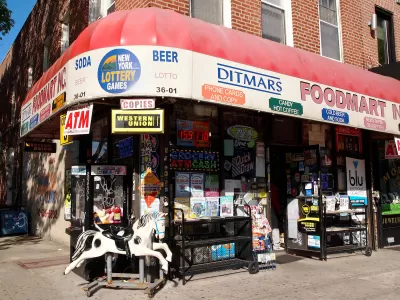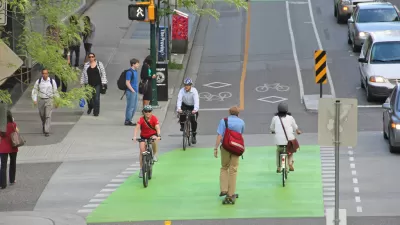A popular walkability assessment omits key factors that impact different demographics and can direct development resources to already wealthy neighborhoods.

A new paper from University of Illinois Chicago and University of California, Berkeley researchers throws into question the well-known ‘Walk Score,’ pointing out that “Windy City census tracts that were rated most highly by the popular real estate algorithm mapped almost exactly onto the census tracts with the highest share of white residents — and a literature review suggested that the same thing is likely true in other dense urban areas.”
Kea Wilson outlines the paper’s findings in Streetsblog USA., noting that researchers Kate Lowe and Anna Brand attribute this in part to the fact that the Walk Score scoring system omits significant factors such as pedestrian crash rates and pedestrian infrastructure, as well as what percentage of people actually walk instead of driving. “And it certainly doesn't get at how notions of ‘walkability’ might vary between different groups, like whether a resident can actually afford the boutique or shop at the non-halal grocery store on the corner, whether their kids get bussed to the school across town rather than the one down the block, and whether they're subjected to jaywalking laws that disproportionately target people of color practically every time they step foot into heavily-policed neighborhood.”
According to the researchers, ignoring these nuances skews results towards neighborhoods that already have desirable amenities and outright ignores some types of businesses. “Moreover, Lowe and Brand say that Walk Score tends to give even more points specifically to areas with a lot of restaurants, bars, shopping, coffee shops, and other ‘spaces of consumption’; places of worship, though, aren't included at all, and corner stores may not merit extra points, even though the researchers point out that they ‘can be important food sources in some low-income communities.’”
Calling the Walk Score tool a “self-fulfilling prophecy,” the researchers caution that “A market urbanism that suggests universal provision of walkable neighborhoods will fix inequities doesn't reflect the structural forces [in our cities] — and WalkScore, in particular, is about investment flows.”
FULL STORY: Is ‘Walk Score’ Really Just a ‘White Score’?

Planetizen Federal Action Tracker
A weekly monitor of how Trump’s orders and actions are impacting planners and planning in America.

Congressman Proposes Bill to Rename DC Metro “Trump Train”
The Make Autorail Great Again Act would withhold federal funding to the system until the Washington Metropolitan Area Transit Authority (WMATA), rebrands as the Washington Metropolitan Authority for Greater Access (WMAGA).

The Simple Legislative Tool Transforming Vacant Downtowns
In California, Michigan and Georgia, an easy win is bringing dollars — and delight — back to city centers.

The States Losing Rural Delivery Rooms at an Alarming Pace
In some states, as few as 9% of rural hospitals still deliver babies. As a result, rising pre-term births, no adequate pre-term care and "harrowing" close calls are a growing reality.

The Small South Asian Republic Going all in on EVs
Thanks to one simple policy change less than five years ago, 65% of new cars in this Himalayan country are now electric.

DC Backpedals on Bike Lane Protection, Swaps Barriers for Paint
Citing aesthetic concerns, the city is removing the concrete barriers and flexposts that once separated Arizona Avenue cyclists from motor vehicles.
Urban Design for Planners 1: Software Tools
This six-course series explores essential urban design concepts using open source software and equips planners with the tools they need to participate fully in the urban design process.
Planning for Universal Design
Learn the tools for implementing Universal Design in planning regulations.
Smith Gee Studio
City of Charlotte
City of Camden Redevelopment Agency
City of Astoria
Transportation Research & Education Center (TREC) at Portland State University
US High Speed Rail Association
City of Camden Redevelopment Agency
Municipality of Princeton (NJ)




























